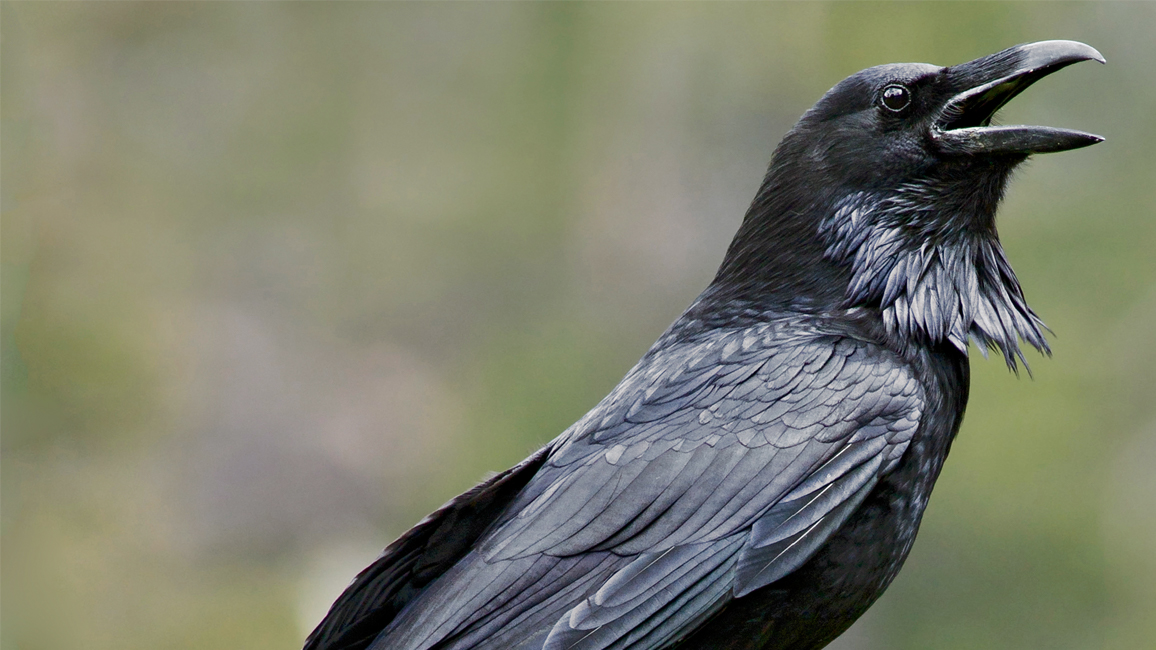
Bird Brainiac
By Ellen LambethPeople say that the raven is one of the world’s smartest birds. See if you agree.
KRRRRAAAH!
A loud, deep, gurgling croak rings out from above. You look up and trace the sound to a big, black bird. But it’s not the caw of a crow you hear. It’s the call of the crow’s cousin, the raven.
WHERE IN THE WORLD?
There are nine species of ravens in the world. But this story is about the one you’re most likely to see in the United States: the common raven. This raven lives throughout much of the northern hemisphere—places above the equator. Ravens aren’t picky about where they hang out, although in the eastern United States, they’re more likely to be in the mountains. And you won’t find them at all if you live in the Southeast or the Great Plains states.
WHICH IS WHICH?
Ravens and crows look a lot alike. Unless you hear them or see their tail shapes in flight, it might be hard to tell them apart. If you could see the two birds side by side, the bigger one would be the raven. It also has a heftier bill, as well as a scruffy-looking “beard” of feathers that the crow doesn’t have.
If there’s a big buffet available somewhere, ravens will flock to it. Otherwise, they tend to hang out solo or in pairs. Crows spend much more time in flocks. But both kinds of birds are well known for their smarts!
THE TRICKSTER
There are many different Native American tales about the raven as a character that created the world. But it was a dark world. Through tricks, Raven was able to steal light that had been kept hidden. He flung it into the sky to make the sun, moon, and stars. Then he stole fire from the sun. He also stole salmon from the “Beaver people,” but kept dropping the fish till they filled the rivers. Even though Raven was selfish and mischievous, his tricks actually made the world a better place. Or so the story goes.
Real ravens don’t have magical powers, of course. But they are very observant and very clever. And that makes them crafty experts at finding food. They eat just about anything they come across, including other birds, small mammals, fish, reptiles, amphibians, and creepy-crawlies of all kinds—as well as eggs, seeds, nuts, fruits, and already-dead animals.
Don’t leave pet food or open garbage outside in raven territory. And never turn your back on a picnic where a tricky raven can find it. The raven will rummage through everything until it finds a yummy prize—even if it’s tucked away or zipped up tight. Then it will steal it, of course. As you can imagine, two ravens are twice as good at getting food as a single raven is. That’s why they may work together as a team.
CAUGHT IN THE ACT
There are many reports of ravens figuring out clever ways of finding food. One raven was discovered stealing fish whenever an ice fisherman walked away from his line. The raven would watch till it saw a pull on the line. Then it would fly over to the hole in the ice, pull part of the line out of the water with its bill, and hold down the line’s slack with its foot. Pull after pull, it would keep this up until the hooked prize was all the way out of the water. Then, of course, the raven would make off with the catch.
HEAD OF THE CLASS
Ravens have been written about for centuries. Usually, they’re described as smart, rascally, fun-loving creatures. People have watched ravens flying like aerial acrobats—even upside down! They have watched them carry items up into the air and drop them, only to fly down and catch them again in mid-air. They have watched them turn onto their backs to sled down snow-covered hills. And they have watched them teasing other creatures.
Scientists know animals that play just for fun also tend to be very intelligent. They also know ravens have big brains for their body size. But can they prove the birds’ intelligence? To do just that, scientists have set up problem-solving experiments for ravens.
The experiments involve food treats located just out of reach. The raven sees the treat but can’t get to it right away. Maybe if it pulls, pushes, or turns something, the treat will move to a spot where the raven can reach it. Turns out, the raven usually gets the reward, even if it has to go through several steps first. Like the fish-stealing bird, ravens show that they can, in fact, think creatively and solve problems!
“Bird Brainiac” originally appeared in the October 2015 issue of Ranger Rick magazine.
(Click on each image above for a closer view of the story.)



















